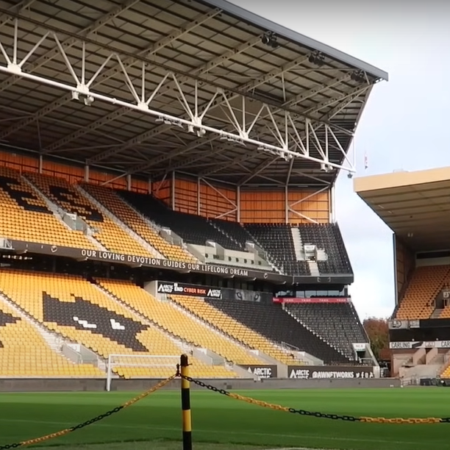
🏛️ Origins & Early Years
-
The stadium stands on land once owned in the 18th century by Benjamin Molineux, originally as a pleasure park and hotel, evolving into Molineux Grounds by the mid‑19th century Visit Birmingham+14StadiumDB+14YouTube+14SeatUnique.
-
In 1889, Wolves leased the land from a local brewery to create the first purpose‑built stadium for a Football League club. The inaugural match was played on 7 September 1889, when Wolves beat Notts County 2–0 before about 4,000 spectators StadiumDB+3Molineux News+3Sports Tips+3.
🧱 Expansion & Landmarks
-
Wolves acquired the site in 1923 and immediately built the Waterloo Road Stand, later replaced with the regulatory Billy Wright Stand in the early 1990s Football Ground Guide+2Sports Tips+2Wikipedia+2.
-
By 1932, all four stands were in place for the first time, providing a classic, compact stadium shape that lasted for decades StadiumDB+2Molineux News+2Sports Tips+2.
-
In 1953 and 1957, Molineux was one of the first English grounds to install floodlights, allowing high‑profile international club friendlies—such as Wolves vs Honvéd in 1954—to be hosted under lights, attracting large crowds and national TV coverage Alamy+14Wikipedia+14Wikipedia+14.
⚠️ Financial Crisis & Rescues
-
The construction of the John Ireland Stand in 1979 cost a reported £1.5m–£2m, triggering a financial meltdown. The club entered administration, suffering back-to-back relegations from 1982 to 1986, and two of the stands were mandated closed for safety reasons amid poor attendances Wikipedia+1Wikipedia+1.
-
In 1986, Wolverhampton Council purchased the stadium, saving the club, while adjacent development deals cleared debts Wikipedia+1Wikipedia+1.
🔧 Modern Redevelopment (1991–2012)
-
Under Sir Jack Hayward’s ownership (from 1990), three sides of the stadium were rebuilt between 1991 and 1993 to become all-seater, compliant with Taylor Report standards:
-
Billy Wright Stand (replacing Waterloo Road)
-
Stan Cullis Stand (former North Bank)
-
Sir Jack Hayward Stand (South Bank, originally John Ireland Stand) Wikipedia+5Wikipedia+5Football Ground Guide+5.
-
-
These three stands remained largely unchanged for nearly 20 years as the backbone of the modern Molineux.
🏟️ Recent Upgrade
-
Beginning in 2011, the Stan Cullis Stand was demolished and replaced by a two-tiered structure, opening in August 2012, raising capacity to around 31,700 Alamy+13thewolvessite.co.uk+13Wikipedia+13grecianarchive.exeter.ac.uk+6StadiumDB+6StadiumDB+6.
-
A grander redevelopment plan was proposed in 2019, envisaging expansion up to 50,000 capacity, although no definitive timeline or confirmation has followed StadiumDB+1StadiumDB+1.
📺 Unique Legacy
-
As one of England’s earliest floodlit grounds, Molineux hosted many high-profile European friendlies before UEFA competitions began, especially Wolves’ 1954 victory over Honvéd, a match acclaimed by fans and media alike as a catalyst for the European Cup competition Wolves Molineux Stadium+7Wikipedia+7Wikipedia+7.
📊 Stadium Snapshot
| Feature | Details |
|---|---|
| Opening Year | 1889 |
| Original Design | First stand-built stadium for Football League club |
| Key Stands | Billy Wright, Sir Jack Hayward, Stan Cullis, Steve Bull |
| Capacity | ~31,700 (since 2012 renovation) |
| Renowned For | Early installation of floodlights, European-era friendlies |
| Ownership Shift | Council takeover in 1986 preserved the club |
| 1991–93 Redevelopments | Major rebuild to meet all-seater standards |
| Future Plans | Expansion to 50k proposed (not finalized) |
🟡 Notable Matches
| Date | Fixture | Significance |
|---|---|---|
| 1954 | Wolves 3–2 Honvéd | Sparked idea for European Cup |
| 1960 | Wolves 2–1 Man City | FA Cup semi-final win en route to trophy |
| 2003 | Wolves 4–3 Leicester | Iconic 3-goal comeback in Premier League |
| 2011 | Wolves 2–1 Man United | Ended United’s invincible run |
| 2022 | Wolves 3–2 Spurs | European place charge continues |
| 1971 | Wolves 1–0 Juventus | UEFA Cup quarter-final triumph |
| 1958 | Wolves 6–4 Leicester | High-scoring classic from golden era |
| 2018 | Wolves 1–0 Sheff Utd | Ruben Neves screamer, near-confirmed promotion |
🧠 Why It Matters
-
Molineux’s designs reflect over a century of football evolution in England—from terracing to floodlit innovation and Taylor Report compliance.
-
Its dramatic mid‑80s financial collapse and subsequent municipal rescue are woven into club folklore.
-
Modernisation under Jack Hayward brought stability and a structure that endures today, with further ambitions still on the table.
- Display 30 Products per page

